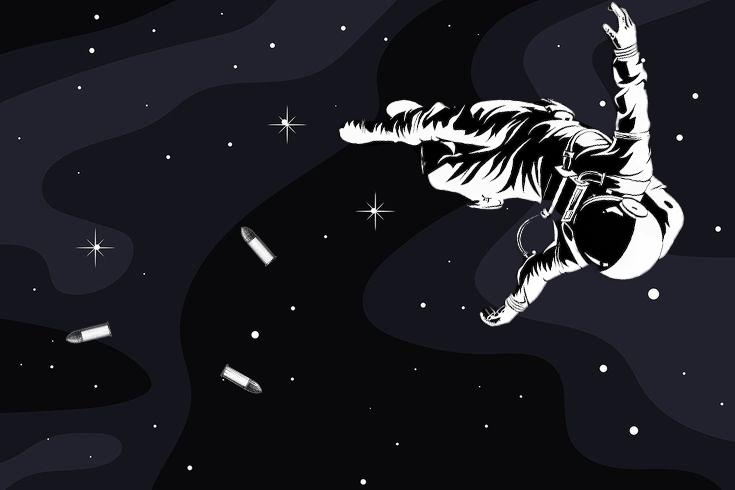- Web Desk Karachi
- 11 Hours ago

Space tragedy: The aftermath of murder and the shirts it wears

Two killings, both shootings, worlds apart in meaning, happened this past month. One, the Wisconsin school shooting, the latest testament to the United States’ egregious lack of gun safety. The other, the assassination of the UnitedHealthcare (UHC) CEO, the first crack in the pane of glass holding back the deluge that is the simmering class war. Despite their lack of similarity, they do share common ground. To wit, their high profile nature.
Both events, one horrid, the other seemingly debatable, reveals less explored aspects of the West’s relationship to such killings. The aftermath. And as crude as it may seem, and as jarring as it may be, a certain song lyric from David Bowie’s hit single “Space Oddity” may help pull back the curtain.
After Major Tom ventures forth into space, ground control apprises him of the momentous occasion’s gravity.
“You’ve really made the grade,
And the papers want to know whose shirts you wear.”
In two lines, Bowie illustrates a modern equation. A culture of fan worship plus a capitalist society equals businesses’ willingness to wring out even the most taboo events of all their monetary worth. Within moments of reaching space, the world beneath Tom knew his name. Before floating into the dark, the papers knew there was money to be made.
In the same way, Luigi Mangione had also made the grade. Within hours of the assassination, the yet unknown and at large man was a folk hero. Before the nationwide manhunt ended at a McDonalds, internet sleuths had identified the clothing that the suspect had worn in surveillance photos. It was a $225 olive-green Levi’s jacket.
Forty eight hours later, over 700 of them had sold on Macy’s website. So what was it that drew the public to him? And did the commodification of a killing begin and end with the shirts the suspect wore?
Also read: Bias, bubbles, and black holes: Prejudice in political journalism

Three Magic Words
The bullets of Mangione’s 3d-printed gun were not suspended in space like Major Tom. Yet, they crossed over into land just as uncharted. One of the untouchables could no longer be defined as such. He had been killed. In broad daylight.
Whether UHC’s Brian Thompson’s death leads to any modicum of change, or whether it only serves to reinforce the elite’s security, reifying the insurmountable class divide in the process, three things will remain etched into peoples minds. The same three words etched into the bullet casings left at the scene of the murder. Delay, Deny, Depose.
Similar words had been read before in Jay Feinman’s 2010 book “Delay, Deny, Defend”, which details how insurance companies are able to withhold services. But this time, those words were emphasised by blood. And despite the silencer on the gun, they were heard oh so loud.
Those three words reverberated across international media and resonated with the mass public. Never had an assassination seen as much support. “Why would we feel sympathy for one who has killed so many?” was the question on some minds. “Is murder in cold blood really a solution you can stomach?” was the question on others. But for a different, more profit-driven subset of people, there was no time for questions. They had to move fast, because those three words were trending.
They didn’t just make shirts. There were hats, wine tumblers, necklaces, mugs, keychains, phone cases, lawn signs, and whatever else you could imagine that could fit those words on it. And with the holiday season around the corner, it would have been a waste to not have Christmas themed products. So there were tree ornaments and holiday sweaters. One Christmas sweatshirt in particular sold over 1,000 units on the TikTok shop.
The instantaneous commercialisation of Thompson’s assassination reveals a simple truth about the aforementioned equation. People will spend money to echo and express their contempt. However, dig an inch or two deeper, and that silver truth gives way to gold.
It’s not just anger. Businesses capitalise on peoples’ fervour, whatever form it comes in. Even if the person who spawns it is considered more of a villain than a folk hero.
Also read: Stalemate: The precarious relationship between athletes and reporters
Bulletproof
Like Mangione, 15 year-old Wisconsin shooter Natalie Rupnow is emblematic of a larger issue. However, rather than representing a retaliation to institutions’ vile practices of exploitation, school shootings are the evil itself. Hence, instead of commercialising the public’s anger, which Luigi embodied, businesses prey upon the personification of parent’s fears.
A horror animated by the horror evoked from not only the most recent school shooting, but also all those that came before. A frightening visual that presents a child in danger. Accordingly, it is not a shirt they wear. It is a bulletproof vest. And that is something that can be and has been sold, to the profit of billions of dollars.
Over three billion to be exact, according to Omida, and the industry experiences an annual growth of eight percent. For all that money, companies fit schools with bulletproof glass, window exits, and collapsable safe rooms. School staff undergo safety training programs. Parents are sold bulletproof bags and school supplies. And the newest innovation in school safety even involves artificial intelligence.
Pennsylvania based company ZeroEyes accesses school security cameras across hundreds of school districts, sending the images back to their command center where AI scans them for firearms. Staff are notified of suspicious images and can then immediately dispatch authorities.
But, can the window of opportunity that this system hopes to create save lives? Possibly, but for tens of thousands of dollars annually, ZeroEyes can’t even detect concealed weapons. For all that money, the window provided is hopelessly small.
Yet, as has been said, it operates across hundreds of school districts. According to Rutgers Sociology, Anthropology, and Criminal justice professor Daniel Semanza, it’s not money well spent.
“It’s a fear response, and an empowerment.”
Educational institutions will continue to take placebos to alleviate their sense of helplessness, as measures taken to buff school security will never address the core of the issue.
That deliberate aversion betrays a second facet of the aftermath. The obscuration of the roots of tragedy, made possibly by certain concerned parties who propose that another layer lies beneath the shirt the perpetrators wear.
Also read: Seeing is believing: laws that displace and narratives that paint
Background Check
While businesses profit, politics come into play, in two major ways. First comes an exposé. Either worn unabashedly on one’s sleeve, or deduced when the dust settles and the death is laid bare to see.
Mangione’s case is an exemplar of the former. In case the bullet casings were too ambiguous, he outlined his motivation in the plainest of terms. “Frankly, these parasites simply had it coming,” he wrote.
His manifesto reminds the world that while the US has the most expensive healthcare system in the world, it ranks forty second in life expectancy. He berrates UnitedHealth for abusing the country for “immense profit because the American public has allowed them to get away with it.” The enemy of Mangione, and the enemy of the people, are health insurance companies, especially those who occupy leadership positions within them.
Rupnow’s manifesto was also leaked online, but it was never considered within the discourse. The death of children has become too commonplace. For as tragic an event as it was, it didn’t have enough shock value to pierce the already established, rigid borders of conversation. After all, it was just one school shooting in a year with 83, the most the US has ever seen. The enemy of educational institutions, and the enemy of parents was already and will continue to be those who advocate for lax gun laws, especially groups like the National Rifle Association that refuse to see the least common denominator.
Regardless, whether it’s other healthcare CEO’s or the NRA, groups that find themselves with the proverbial barrel at their temple must do their best to survive. Their goal at naive best is to unearth the spiral that turned them into miscreants, and in cold truth is to shape the narrative.
As if bound by fate, with each mass shooting that comes and passes, mental health is put back into the sightline. Rupnow’s case is no different, and is one of the more clear cut instances of a person suffering from mental illness. Her social media posts showcase a romance with violence and those responsible. Court documents reveal familial strife. A child who was forced to split time between homes every two to three days, after her parents divorced twice, and petitioned for a third. The resulting effects on her mental state do not need to be assumed. Her alleged manifesto details the detest she held for her therapist, her parents, and her classmates. It details how she was friendless, alone, and picked on.
“Nobody was there for me and never really has,” Rupnow has written.
There is no doubt that mental health plays a role in tragedy. But to suggest that it takes precedence over gun control demonstrates an abject disregard for the reality of the situation. Research led by Archi Bleyer, a professor at Oregon Health and Science University, found that while the US has comparable rates of mental health conditions to 40 other high SDI countries, they have much higher deaths by firearm.
The same rhetoric is being applied to Mangione and the same disregard holds true. Articles claim that Mangione’s chronic back pain may have exacerbated already existing psychological issues such as depression or anxiety. Other posts go as far as to claim his disdain for social norms sprouted from his poor relationship with his mother, citing an account from Mangione’s childhood in which he was forced to eat with his right hand despite being left handed.
Mangione’s “depression” may have pushed him to the edge and his estrangement from his family may be an indication of his deteriorating mental state. However, these suggestions serve to create a nebulous land in which the underlying issues plaguing western society lay unaddressed, in turn shifting the blame away from the groups that find themselves under siege.
A Numb Society
The resulting aftermath of tragedy also serves as an indication of something else. The complete numbing of society, starkly apparent from the ease people display digesting death.
Fame, commercialisation, and the blame game. All products of the 24/7 news cycle, the sensationalization of each and every event, and the frequency of these attacks. A testament to the mass desensitization is the response to Thompson’s assassination within hours of his death. People bought his killer’s clothes and held look-alike contests.
With the justified hatred for health insurance companies still running rampant, it may be difficult to see the absurdity. To make it clearer, just take another look at Rupnow. A picture of her currently making the rounds shows her in a KMFDM shirt. The band has stated their songs oppose violence, but that hasn’t stopped them from amassing an online cult following of people obsessed with school shootings. In particular, the same shirt was worn by Eric Harris, the Columbine shooter.
Mangione’s following and Rupnow’s own obsession with school shooters isn’t the same. Yet, a hint of similarity exists. The thread on which people balance what is defendable and what is perturbing frays further with each act of lawlessness and its ensuing glorification.
And when that thread snaps, those lost in the balancing act may be left out of reach, adrift in the far expanse of space. Just like a certain astronaut.
“Ground Control to Major Tom
Your circuit’s dead, there’s something wrong
Can you hear me, Major Tom?”







